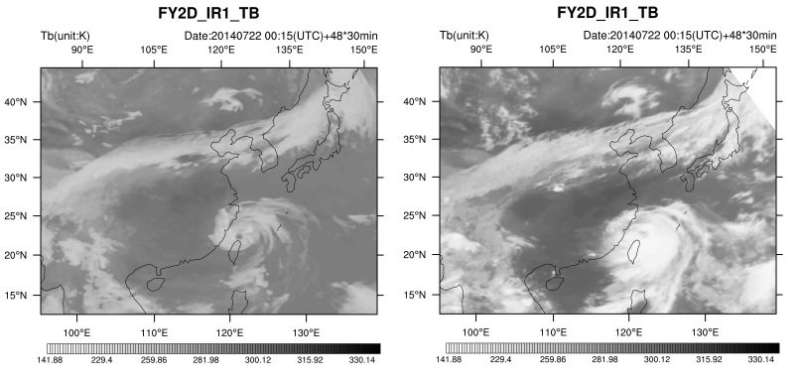How far to go for satellite cloud image forecasting into operation

Cloud is a tracer for a variety of significant weather changes. Cloud images obtained from satellite remote sensing are of great help to weather forecasters in understanding the past and present weather processes in a macroscopic way. Forecasts made directly via satellite cloud images are a major goal of meteorologists and forecasters. Recent studies have shown that it is possible to produce satellite cloud image forecasts for up to tens of hours.
A research paper authored by Shi Xiaokang, Li Yaodong, Liu Jianwen, Xiang Xizi, and Liu Le, from the Beijing Aviation Meteorological Institute, present a method for simulating FY-2-D infrared cloud images, and analyzes in detail the effects of simulation errors in WRF regional numerical weather cloud parameters on the simulation accuracy of brightness temperature of FY-2-D infrared channel.
Adopting the high-resolution WRF regional numerical weather prediction model products and the forward radiation transfer model RTTOV, the five researchers have made an attempt to simulate the infrared channel brightness temperature of a geostationary meteorological satellite, and compared it with the actual satellite cloud images.
The results show that the correlation coefficients of simulated and observed brightness temperatures of the four infrared channels are all greater than 0.5 from zero to 24 hours, and the root mean square error (RMSE) of each channel is controlled at 10 to 27 K, which is better than that of the previous research result of 20 to 40K. The distribution pattern and structure of the weather system reflected by the predicted cloud image have a high similarity with the actual satellite cloud image, which can provide a certain reference for forecasting the weather.
The success or failure of the cloud image forecast mainly depends on two factors: the accuracy of the numerical weather forecast, and the rationality of the radiation transfer model. Most critical for the numerical weather forecast is the atmospheric temperature and humidity structure of model and the precision and accuracy of macro- and micro-scale process predictions of clouds, while the radiation transfer model focuses on the accurate description of different atmospheric structures, especially cloud and rain weather processes.
The emphasis of this research is put on the simulation and effect verification of the sensitivity of the current general fast radiation transfer model to the numerical model cloud macro and micro prediction products. The results show that improving the forecasting ability of the model and the adaptability of the radiation transfer model to different cloud processes will be an important direction for future research.
Ever-changing clouds are difficult to predict. The current cloud image forecast can only provide some references for the development of cloud systems with large scales and longer life cycles. However, with the advancement of technology, high-precision numerical weather forecasting for various types of weather processes is bound to become stronger, and the radiation transfer model will become more reasonable. So the forecast of satellite cloud images that can directly reflect the macroscopic change of clouds will be closer to the operational application.
More information: Xiaokang Shi et al, Simulation of FY-2D infrared brightness temperature and sensitivity analysis to the errors of WRF simulated cloud variables, Science China Earth Sciences (2018). DOI: 10.1007/s11430-017-9150-0
Journal information: Science China Earth Sciences
Provided by Science China Press


















